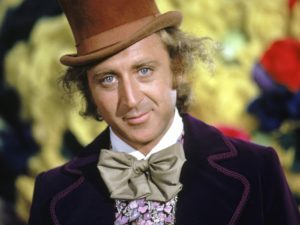Tropic Sprockets / Remembering Gene Wilder
By Ian Brockway
In the late 20th century, one actor embodied the definition of good-natured madcap comedy: a man named Gene Wilder. In the documentary “Remembering Gene Wilder,” the iconic man as hectic performer forges thru life’s episodes in brilliant color complete with frizzy hair and staring intense eyes. [Showtimes at Tropiccinema.com.]
Wilder was one actor who went full throttle in whatever he did, and his acting was given with great feeling, without malice or cynicism. He gave to the audience what he had to give, in freedom and without judgment.
He was born Jerome Silberman. When Wilder was a young boy, his mother had a heart attack so he reasoned that he would keep her laughing to make her healthy. He was warned by the doctors never to argue with her.
After a run on Broadway in Mother Courage, Wilder caught the eye of a young Mel Brooks, but not before he went on to play an unfortunate passenger in “Bonnie and Clyde.” Wilder did very well in “The Producers” but it was not a box office winner upon first release. Wilder then starred in “Willy Wonka and the Chocolate Factory” and a family staple was born along with another couple of outrageous outings with Brooks, “Blazing Saddles” and “Young Frankenstein” an eccentric tribute piece to James Whale films, which was rendered in black-and-white and angered executives.
Wilder went wilder than most actors in all projects including a Woody Allen film that required him to be romantic and loving to a sheep. Aside from “Willy Wonka,” the actor was often known for outrageous roles in films with cult status.
Wilder soon got an idea to star with the legendary comedian Richard Pryor in buddy comedies such as “Stir Crazy” and “See No Evil, Hear No Evil. In addition to creating a new genre, Wilder and Pryor broke down assumed racial barriers with their sincere rapport.
Much time is given to Wilder’s electric madcap technique and how he “lets go.” Also well handled is his generosity both professionally and publicly as well as his romance and natural charm.
The wondrous Gilda Radner was a great love to him. Less attention is given to any darkness the actor has, if any, or his heartfelt and striking paintings which are very good, full of color and mystery. There is little mention of these works, and for an actor who plays manic characters, there is only slight insight on how Wilder feels about the mania of life and its chaotic orbit. One learns that the actor spent time working with patients in a psychiatric hospital, but this is given only passing treatment.
One hungers for more.
We are presented with Wilder as a rambling man going from one adventure to another, mostly in a state of pensive joy with a leap in his smile. There are dark moments: Gilda’s cancer and Wilder’s Alzheimer’s. There is a mention of anger and this would be entrancing, had one been given a bit more detail. Somewhat cryptically, for the most part, the actor’s life seems only a breezy summer circus in the light pastel tones of his watercolors.
The best and most visceral aspect of the film is contained in Gene Wilder’s own voiceover, which is gentle and charming, full of warm feeling and a tranquil joy over what he has seen.
After the hysterical histrionics, the tense tumbles, and sinister somersaults in a purple top hat, we are only left with the actor and the acrobat of happy accidents as an odd cypher, and one feels a bit slighted with a yearning as tangled as Wilder’s electrified hair.
Write Ian at [email protected]
[livemarket market_name="KONK Life LiveMarket" limit=3 category=“” show_signup=0 show_more=0]

No Comment